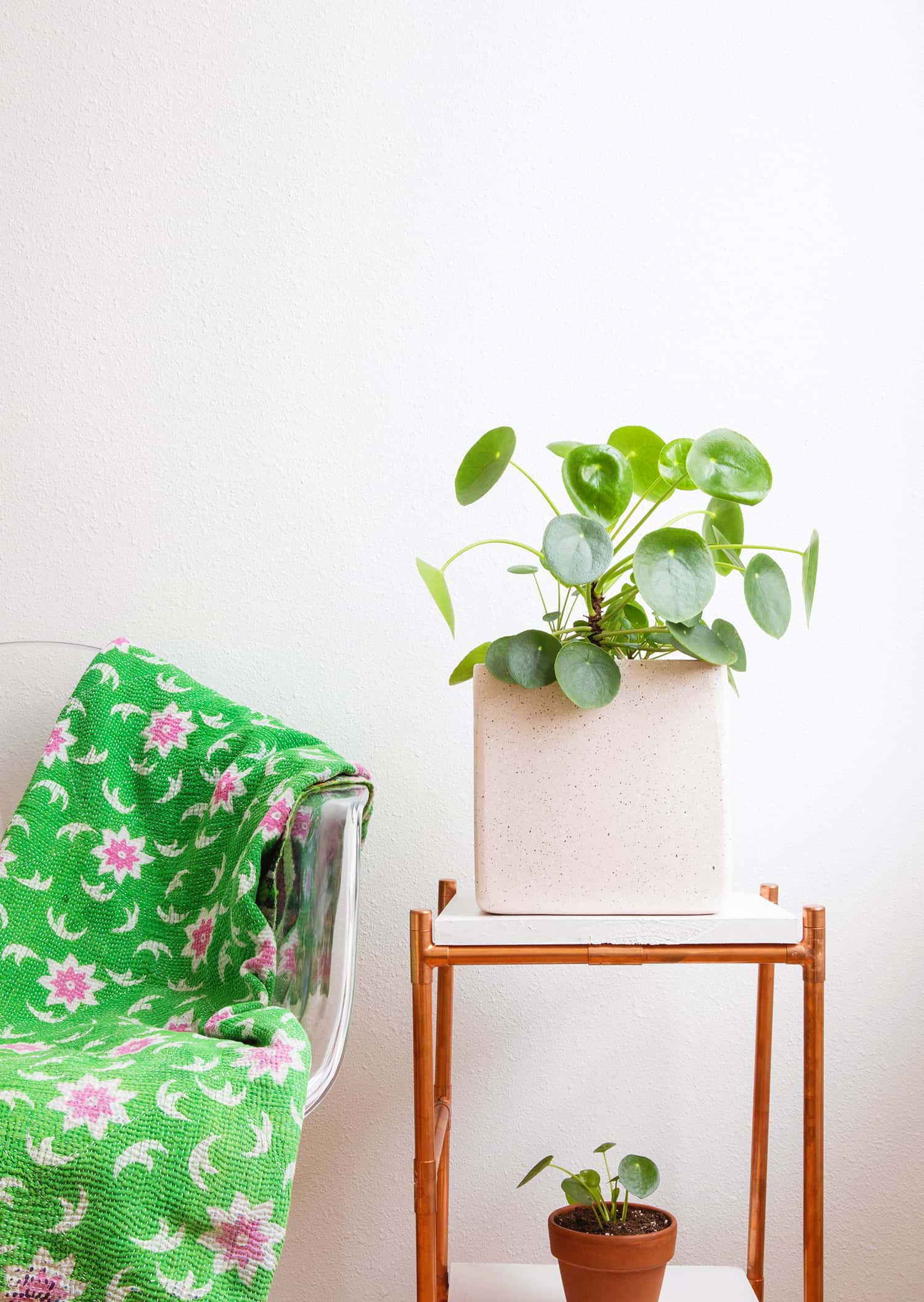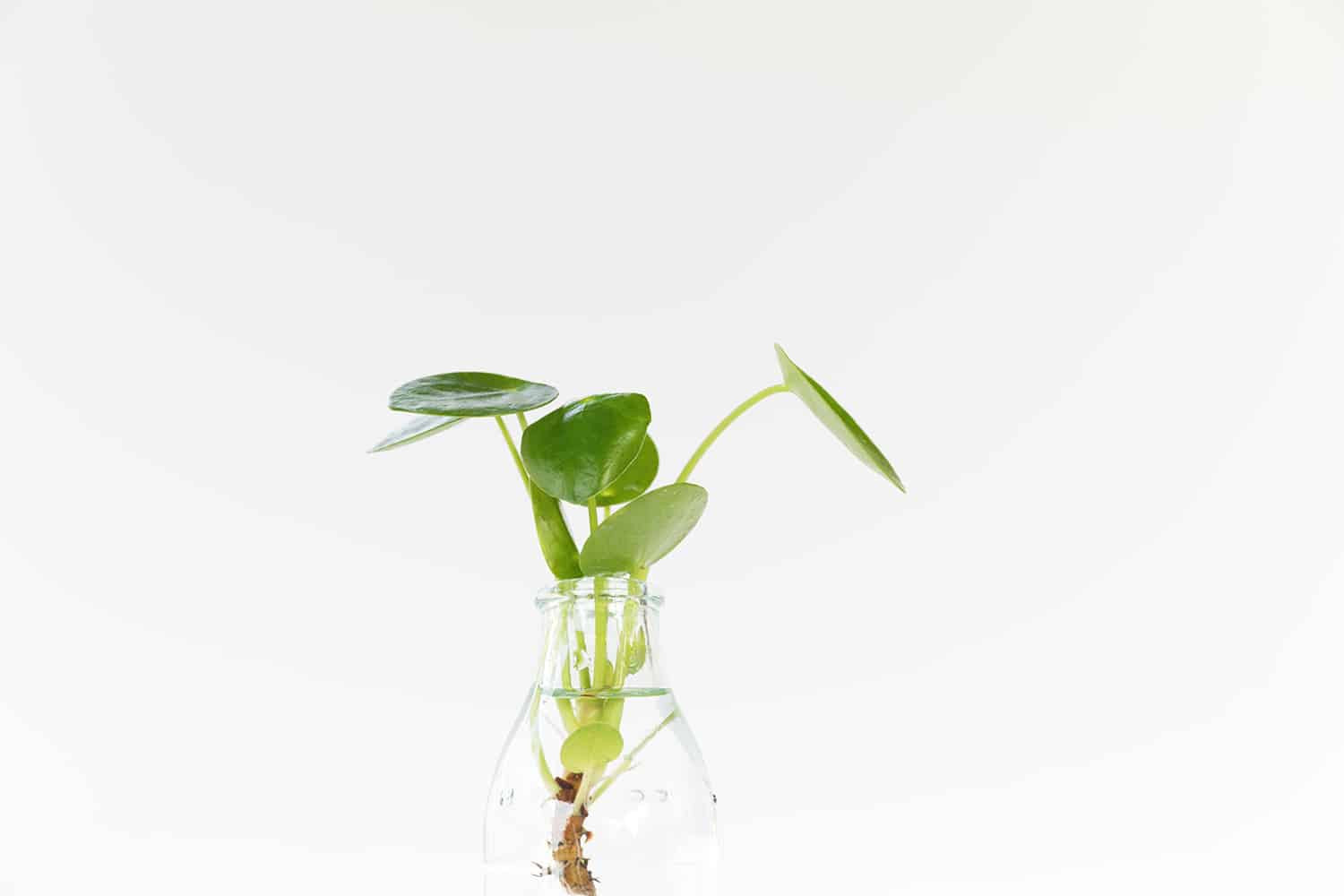The Pilea Peperomioides, affectionately known as the Chinese Money Plant, is a delightful and trendy houseplant that brings a touch of whimsy and good fortune to any space. Its unique, coin-shaped leaves and easy-going nature have made it a favorite among plant lovers, both beginners and seasoned enthusiasts alike. Not only is the Money Plant aesthetically pleasing, adding a pop of green to your home, but it’s also incredibly simple to care for, making it a rewarding addition to your indoor garden.
 Pilea peperomioides plant on a clear chair with a green and pink blanket, showcasing its decorative appeal in a home setting
Pilea peperomioides plant on a clear chair with a green and pink blanket, showcasing its decorative appeal in a home setting
Originating from the Yunnan province in Southern China, the Money Plant has an intriguing history, spreading across the globe through informal sharing rather than commercial distribution for many years. This charming plant earned its common name, Money Plant, due to its round, flat leaves resembling coins, symbolizing wealth and prosperity in many cultures. Beyond its symbolic value, the Pilea is simply a joy to own. It grows vigorously, producing “pups” or baby plants readily, allowing you to expand your green collection or share the joy of growing with friends and family.
If you’re looking to add a touch of green luck to your home, or are simply captivated by the unique charm of the Pilea Peperomioides, this comprehensive guide will provide you with all the essential tips and tricks to ensure your Money Plant thrives. Let’s delve into the world of Money Plant care and discover how easy it is to cultivate this delightful indoor companion.
Essential Care Tips for a Thriving Money Plant
Caring for a Money Plant is straightforward, making it an excellent choice for those new to plant care or seeking low-maintenance greenery. By understanding its basic needs, you can easily nurture a healthy and happy Pilea. Here are the key aspects of Money Plant care:
Light Requirements: Bright Indirect Sunlight is Key
Money Plants are light-loving plants, but they thrive in bright, indirect sunlight. Direct sunlight, especially harsh afternoon sun, can scorch their delicate leaves, causing brown spots or sunburn. The ideal location for your Pilea is near a window that receives bright, filtered light. East or west-facing windows are generally perfect, offering gentle morning or afternoon sun. If you have a south-facing window, placing your plant slightly away from the window or using a sheer curtain to diffuse the light can prevent leaf burn.
Signs that your Money Plant is not getting enough light include leggy growth (stretched stems with sparse leaves) and smaller, paler leaves. If you notice these signs, try moving your plant to a brighter location. Conversely, if you see scorched patches on the leaves, it’s a sign of too much direct sunlight, and you should relocate it to a shadier spot.
 Person holding a potted money plant, demonstrating the appropriate size and handling for repotting and care
Person holding a potted money plant, demonstrating the appropriate size and handling for repotting and care
Watering: Finding the Right Balance
Watering is crucial for Money Plant care, and finding the right balance is key to avoiding common issues like root rot. Pilea plants prefer to dry out slightly between waterings. Overwatering is a more common problem than underwatering and can lead to root rot, which can be fatal to your plant.
To water your Money Plant correctly, wait until the top inch of soil feels dry to the touch. You can check this by inserting your finger into the soil. When it’s dry, water thoroughly until water drains out of the drainage hole at the bottom of the pot. Always ensure your pot has drainage holes to prevent water from sitting at the bottom, which can lead to soggy soil and root rot. After watering, discard any excess water that accumulates in the saucer to prevent the plant from sitting in water.
During the active growing season (spring and summer), you may need to water your Money Plant more frequently, perhaps once a week. In the dormant season (fall and winter), when plant growth slows down, you can reduce watering frequency. Always check the soil dryness before watering, rather than following a strict schedule, as environmental factors like temperature and humidity can affect how quickly the soil dries out. A slightly drooping Money Plant is often a sign it needs water, but be sure to check the soil to confirm it’s not another issue, like overwatering or poor drainage.
Potting and Soil: Setting the Stage for Growth
Choosing the right pot and soil is essential for the healthy growth of your Money Plant. Terracotta pots are an excellent choice because they are porous, allowing for better aeration and drainage, which helps prevent overwatering. Ensure your pot has at least one drainage hole at the bottom. If you have a decorative pot without drainage, you can use a terracotta pot inside it for practical purposes and remove it for watering and drainage.
For soil, a well-draining potting mix is ideal. You can use a general-purpose potting mix amended with perlite or sand to improve drainage. Money Plants don’t require very rich soil, so a standard potting mix will work perfectly well. When repotting, which is generally recommended every 1-2 years or when the plant becomes root-bound, choose a pot that is only slightly larger than the previous one. Repotting provides fresh nutrients and gives the roots room to grow, encouraging overall plant health and the production of pups. Placing a layer of small stones or gravel at the bottom of the pot can further enhance drainage, although it’s not strictly necessary if you use a well-draining potting mix and a pot with drainage holes.
 Money plant in a pot placed on a windowsill near a window with sheer curtains, illustrating ideal indirect light conditions
Money plant in a pot placed on a windowsill near a window with sheer curtains, illustrating ideal indirect light conditions
Propagation: Multiplying Your Money Plant
One of the most rewarding aspects of owning a Money Plant is how easily it propagates, allowing you to create new plants from “pups” that grow from the mother plant. These pups emerge from the soil around the base of the plant or sometimes from the stem near the soil line. Propagation is a fantastic way to expand your collection or share these charming plants with friends and family.
The best time to propagate Money Plants is during the spring or summer, the active growing season. Wait until the pups are at least a few inches tall before separating them from the mother plant. To propagate, gently remove the soil around the base of the pup to expose its stem. Using a clean, sharp knife or pruning shears, carefully cut the pup away from the mother plant, ensuring you get some of the root system if possible, though pups root readily even without established roots.
You can root the pups in either water or directly in soil. For water propagation, place the cutting in a glass of water, ensuring that the leaves are above the water line. Place the glass in a bright, indirect light location. Roots will typically begin to form within a few weeks. Once the roots are about an inch long, you can pot the pup in soil. Alternatively, you can plant the pup directly into a small pot filled with well-draining potting mix. Keep the soil consistently moist but not waterlogged until the pup establishes itself and shows new growth. Water propagation allows you to observe root development, which can be quite fascinating and reassuring, especially for beginners.
Fertilizing: Boosting Growth
While Money Plants are not heavy feeders, fertilizing can give them a boost, especially during the active growing season (spring and summer). Fertilizing helps promote healthy growth and vibrant foliage. Use a balanced liquid fertilizer diluted to half strength, about once a month during spring and summer. A 10-10-10 formula is generally suitable. Apply the fertilizer when you water the plant, ensuring the soil is already slightly moist to prevent root burn.
Avoid fertilizing during the dormant season (fall and winter) when plant growth naturally slows down. Over-fertilizing can lead to salt buildup in the soil, which can damage the plant. If you notice white crusts on the soil surface, it could be a sign of salt buildup from fertilizers. In such cases, flush the soil by watering thoroughly until water runs freely from the drainage hole to remove excess salts. Organic fertilizers, like compost tea or worm castings, can also be used as gentle alternatives to synthetic fertilizers.
 Close-up of money plant leaves in a glass vase with water, demonstrating water propagation method
Close-up of money plant leaves in a glass vase with water, demonstrating water propagation method
Common Issues and Solutions
Money Plants are generally resilient, but like all houseplants, they can encounter a few common issues. Being aware of these problems and their solutions will help you keep your Pilea healthy and thriving.
- Drooping leaves: This is often a sign of underwatering. Check the soil moisture and water thoroughly if dry. However, drooping can also occur due to overwatering or root rot. Assess the soil and roots to determine the cause.
- Yellowing leaves: Yellowing leaves can be caused by overwatering, underwatering, or nutrient deficiencies. Check the soil moisture and adjust watering accordingly. If the issue persists, consider fertilizing or repotting with fresh soil.
- Leaf spots: Brown or black spots on leaves can be due to sunburn (direct sunlight) or fungal infections (often from overwatering and poor air circulation). Relocate the plant away from direct sunlight and ensure proper watering and air circulation.
- Leggy growth: Stretched stems with sparse leaves indicate insufficient light. Move your Money Plant to a brighter location with indirect sunlight.
- Pests: Money Plants are relatively pest-resistant, but occasionally, they may be affected by spider mites or mealybugs. Inspect your plant regularly and treat any infestations promptly with insecticidal soap or neem oil.
By paying attention to your Money Plant and addressing any issues promptly, you can ensure it remains a healthy and attractive addition to your home.
Conclusion
Caring for a Money Plant is a rewarding experience. Its unique appearance and easy-care nature make it a delightful houseplant for any plant enthusiast. By providing the right light, water, and soil conditions, you can easily cultivate a thriving Money Plant that brings a touch of green charm and perhaps even a little symbolic prosperity into your home. Don’t hesitate to propagate pups and share the joy of growing these wonderful plants with others! Happy growing!
(Note: No references are explicitly listed in the original article, and as per instructions, no additional information or external links have been added beyond those present in the original article’s text and images.)